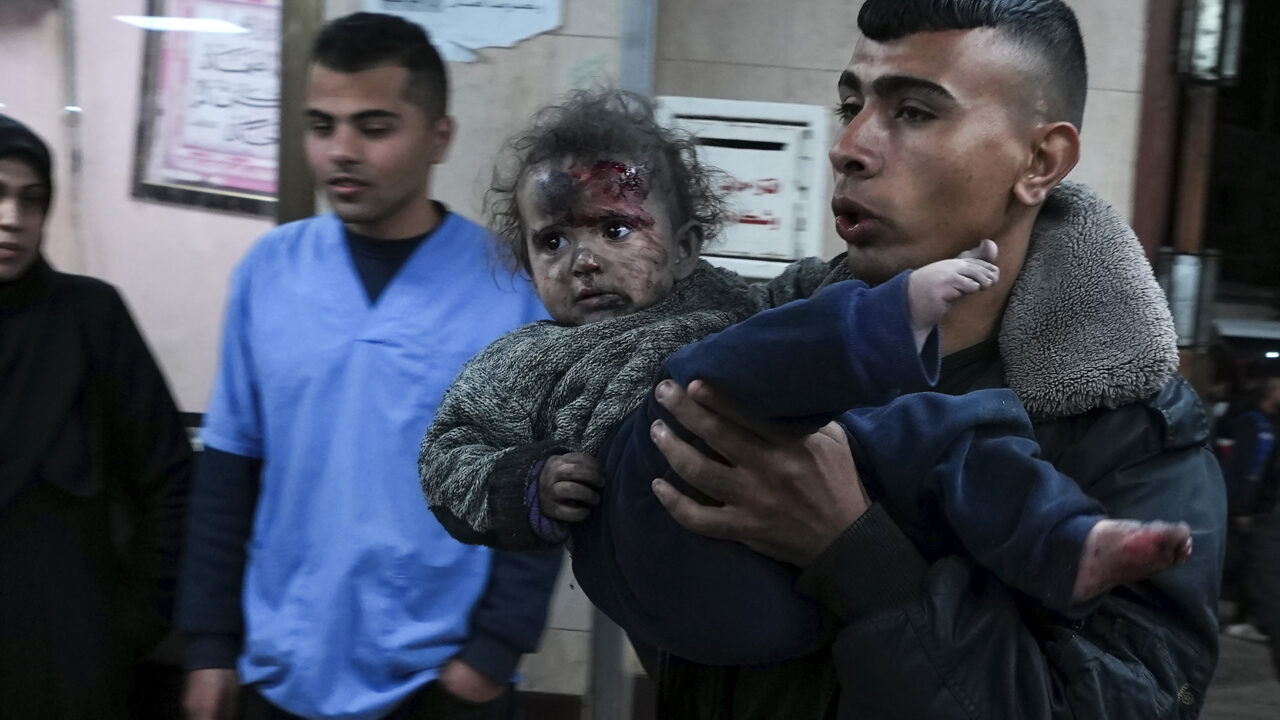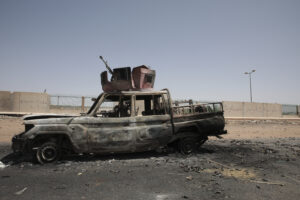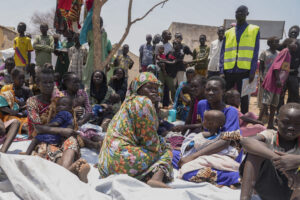Death Toll in Gaza Could Reach 100,000 in 6 Months
A joint report issued this week contends deaths will skyrocket due to starvation and disease unless a ceasefire can be reached immediately. Palestinians wounded in the Israeli bombardment of the Gaza Strip are brought to Al Aqsa hospital in Deir al Balah, Gaza Strip, Thursday, Feb. 22, 2024. (AP Photo/Adel Hana)
Palestinians wounded in the Israeli bombardment of the Gaza Strip are brought to Al Aqsa hospital in Deir al Balah, Gaza Strip, Thursday, Feb. 22, 2024. (AP Photo/Adel Hana)
The Crisis in Gaza: Scenario-Based Health Impact Projections, a joint report by the the London School of Hygiene and Tropical Medicine and the Johns Hopkins Center for Humanitarian Health at Johns Hopkins University, issued this week, warns that a further 85,750 Palestinians could die in the next six months from physical trauma and disease if the conflict in Gaza continues and escalates.
The figure of 85,750 is a worst case scenario and deaths would reach that level only if the military assault on Gaza escalates and if the poor hygienic conditions of the 1.9 displaced Palestinians cause epidemics.
But if an immediate ceasefire were achieved and no epidemics break out, a further 6,550 excess deaths would occur, or 11,580 if there are epidemics.
If Israel goes on fighting for another six months just at its current pace, the death toll rises to 103,603 in the absence of major disease outbreaks.
If there is no epidemic and if the Israeli military campaign continues on its current pattern without a significant escalation, then the death toll would rise by 74,290 over the next six months.
Since the Israeli military had already killed at least 29,313 people in Gaza, 70% of them women and children and the bulk of the remainder being non-combatant men, the study is saying that the total death toll is now fated to rise to between 35,800 and 40,893 even if not another shot is fired.
If Israel goes on fighting for another six months just at its current pace, the death toll rises to 103,603 in the absence of major disease outbreaks.
It seems unlikely that the fighting will go on at the current pace for six months. But it seems highly likely that there will be epidemics. The UN Office for the Coordination of Humanitarian Affairs reported yesterday,
The dire water and sanitation conditions are also aggravating the state of health in Gaza, with more than 300,000 reported cases of acute respiratory infections and more than 200,000 reported cases of acute watery diarrhoea, of whom more than half are children under five, among other outbreaks.
The authors of the “Crisis in Gaza” report say, “Our projections indicate that even in the best-case ceasefire scenario, thousands of excess deaths would continue to occur, mainly due to the time it would take to improve water, sanitation and shelter conditions, reduce malnutrition, and restore functioning healthcare services in Gaza.”
The report only appears to consider deaths from military attacks and disease, and factors in hunger mainly as enabling the latter. People weak with hunger cannot fight off diseases and famine and epidemics go along with one another.
OCHA quotes Dr. Mike Ryan of the World Heath Organization as saying, “Hunger and disease are a deadly combination. Hungry, weakened and deeply traumatised children are more likely to get sick, and children who are sick, especially with diarrhea, cannot absorb nutrients well. It’s dangerous, and tragic, and happening before our eyes.”
Palestinians are also exposed to the cold and wet weather of February in the Levant, which weakens immunity.
But I think they should have considered deaths from hunger alone, since the Israeli government appears to be deliberately keeping the civilian, noncombatant population malnourished by limiting the number of aid trucks, the goods of which are allowed to enter the Strip. The fascist Finance Minister, Bezalel Smotrich, has refused to allow US shipments of flour to reach Gaza, reneging on a promise made to President Joe Biden by Israeli Prime Minister Binyamin Netanyahu. On February 5, Israeli troops in Gaza fired on a food aid convoy they had previously authorized, destroying the food.
OCHA points out that the relief organization Anera “highlighted the ‘silent crisis’ of hunger-induced deaths: ‘In the tragic circumstances of starvation in Gaza, there’s a compounding issue: many who perish from starvation-related symptoms aren’t accurately documented. Their deaths often get attributed to other physical causes, masking the true toll of starvation.’”
I have argued, based on Gaza health statistics, that thousands are already dying silently of hunger in Gaza. I wrote, “OCHA says that the Israeli campaign has left 378,000 people at catastrophic phase 5 levels of starvation. US AID explains that Phase 5 levels of starvation indicate that “acute malnutrition levels exceed 30 percent, and more than 2 per 1,000 people are dying each day.” Given that 378,000 people are being categorized by the UN as at phase 5, this definition suggests that 756 Palestinians in Gaza are dying of hunger each day, which comes to a projected 22,680 deaths from starvation over the next month.”
OCHA observes,
“Catastrophic levels of acute food insecurity are reportedly intensifying across Gaza, with growing reports of families struggling to feed their children and a rising risk of hunger-induced deaths in northern Gaza. The Global Nutrition Cluster is reporting a steep rise in malnutrition among children and pregnant and breastfeeding women in the Gaza Strip. The situation is especially serious in northern Gaza where 1 in 6 children under the age of two (15.6 per cent) who were screened at IDP shelters and health centres in January were found to be acutely malnourished, a decline in a population’s nutritional status that is unprecedented globally in three months. In comparison, 5 per cent of children under the age of two in Rafah were found to be acutely malnourished, evidence that access to humanitarian aid can help prevent the worst outcomes.”
Let me just reiterate that the finding is that among the 150,000 people left in North Gaza, 1 in six children under the age of two are “severely malnourished.” Severe malnutrition has skyrocketed under the Israeli military’s reckless disregard for civilian life.
The London/ Johns Hopkins study concurs: “Before the current conflict, the global acute malnutrition (GAM) and severe acute malnutrition (SAM) prevalences were low amongst children 6-59 months (3.2% and 0.4%, respectively). As of 7 Feb 2024, we project they had already risen significantly (14.1% and 2.8%, respectively), albeit with likely geographical variations.”
Severe malnutrition has skyrocketed under the Israeli military’s reckless disregard for civilian life.
They don’t think a ceasefire will help with this issue of child malnutrition very much, with GAM and SAM only reduced slightly — “(12.4% and 2.7% at 6 months, respectively.” In contrast, they fear that if the military campaign continues for six months, child malnutrition will increase many times over.
As for the possibility of epidemics, they write: “If epidemics also occur, those that are projected to cause the most excess deaths are cholera (3,595-8,971), polio (both wild-type and vaccine-derived; 1,1145-2,444), measles (260-793), and meningococcal meningitis (24-143).”
So cholera is the big threat and could cause almost 10,000 deaths over the next six months all on its own. When I lived in Eritrea in the 1960s I knew a teenager who contracted cholera. He survived, but spent days expelling liquid from all his orifices. It was horrible. You die of dehydration.
The citation for the report is: Zeina Jamaluddine, Zhixi Chen, Hanan Abukmail, Sarah Aly, Shatha Elnakib, Gregory Barnsley et al. (2024). Crisis in Gaza: Scenario-based health impact projections. Report One: 7 February to 6 August 2024. London, Baltimore: London School of Hygiene and Tropical Medicine, Johns Hopkins University. The pdf is here.
Your support matters…Independent journalism is under threat and overshadowed by heavily funded mainstream media.
You can help level the playing field. Become a member.
Your tax-deductible contribution keeps us digging beneath the headlines to give you thought-provoking, investigative reporting and analysis that unearths what's really happening- without compromise.
Give today to support our courageous, independent journalists.





You need to be a supporter to comment.
There are currently no responses to this article.
Be the first to respond.